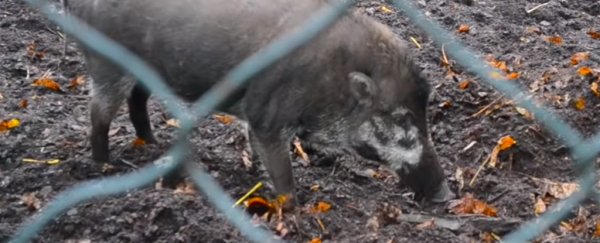Over millions of years, humans have developed a talent for transforming bits of nature into objects that make daily tasks easier. We got so good at it, we started to think tool-use among animals was a rather exclusive club - as it turns out, we were wrong.
Adding to the long list of animals that use tools, we now have evidence that suggests pigs might be using sticks to construct their nests.
We've long known that other apes can make and use tools. So can crows. Dolphins use sponges to protect their snoz while foraging. Octopuses have an interesting use for coconut shells. Given their smarts, it's shocking that science has been silent on the topic of porcine tool use.
"When I looked up tool use in pigs, there was nothing," Université Paris-Saclay ecologist Meredith Root-Bernstein told Christine Dell'Amore at National Geographic.
Yet when Root-Bernstein visited the famous Jardin des Plantes zoo in Paris in late 2015, that was exactly what she saw – a Visayan warty pig (Sus cebifrons) using a piece of bark to push around loose soil in its enclosure.
Her observations would have been a prime opportunity to fill a gap in the literature. Sadly, over successive months, Root-Bernstein didn't get a repeat performance to analyse further. But every time she stopped by, that notable bark shank was lying somewhere different in the enclosure, often suspiciously near a patch of churned earth.
Figuring it might have something to do with the species' desire to build nests, Root-Bernstein returned the following year with several colleagues to solve the mystery of the potential digging stick.
During the winter months, a member of Root-Bernstein's team hid food in an effort to identify whether foraging behaviour might help explain the potential tool use.
When this proved to be a dead end, the team came back the following October to watch the pigs during their nesting season. It was then the team noticed the adult female – which they affectionately named Priscilla – using a piece of wood to move soil.
Priscilla wasn't the only one to show interest in gardening. Her two daughters also used a short piece of bark to dig around at various times during the observation period, integrating the tool use into other behaviours associated with nest-building.
The enclosure's only male – a pappa Visayan warty pig they called Billie – also reportedly had a go at using the stick one day, picking up where one of the younger pigs had left off.
"Billie then investigated the stick and carried it off in his mouth, walking about the fence for a while before dropping it," UNESCO Local and Indigenous Knowledge Systems expert Trupthi Narayanc was quoted in the report.
"After some time, he picked up the stick and attempted a rather clumsy digging action."
Just to see if there was something special about these small lengths of bark, Root-Bernstein and her colleagues gifted the pigs with a selection of less natural implements in the form of wooden spatulas of various designs.
The pigs weren't exactly… grateful. Priscilla used one of these implements twice on day one of the test. And that was it. The unnatural tools then all went missing, either buried around the enclosure or stashed away in their huts.
As interesting as the study is, it poses far more questions than it really answers.
For one thing, the use of the stick didn't seem to make the process of nesting any more efficient. It was never seen at the start of nest building, and didn't seem to substitute the use of the pigs' feet or snouts in churning the ground.
That suggests it's unlikely to be an innate activity. Instead, at some stage some pig started to flip soil with a stick and – for whatever reason, whether for fun or habit – the activity stuck around.
Since Billie was such a klutz with his stick, we can safely assume he's not the genius behind the discovery. It's not clear whether Priscilla might have learned stick-digging in the zoo where she was born, or if she came up with it herself and passed it to her family.
Given these animals were all born in captivity, and the sample is so tiny, it's hard to draw any solid conclusions. But that isn't really the point.
If the behaviours have anything to say about pig culture, it's that we need to now consider the possibility that at least some pig species use found objects in association with tasks such as nesting.
At the very least, Root-Bernstein's observations lay the groundwork for further studies on wild pigs with an appreciation for their potential skills in tool use.
This research was published in Mammalian Biology.
